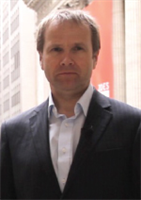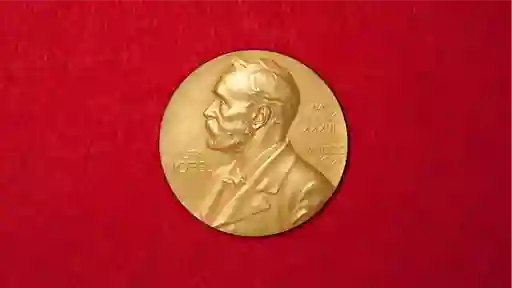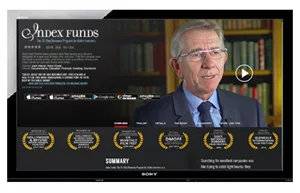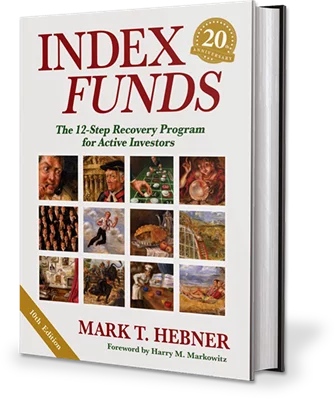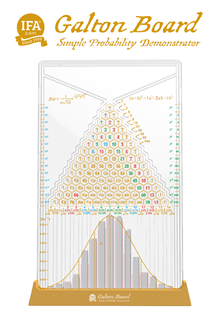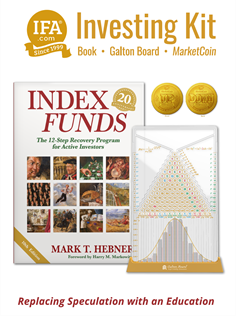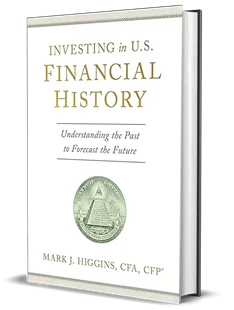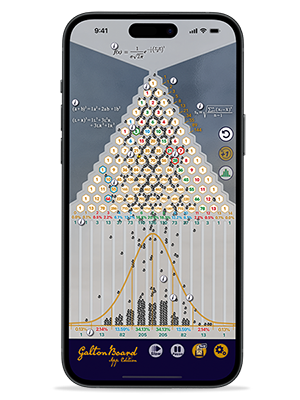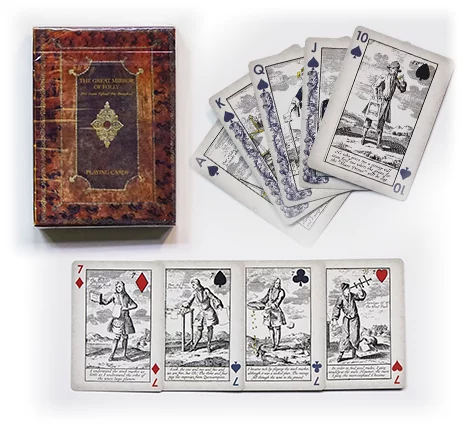The 2025 Nobel Prize in Economic Sciences explains why capitalism has sustained growth for two centuries through wars, crises, and technological upheavals. For index investors, the laureates validate a crucial insight: you own a self-renewing system, not a static collection of companies.
The 2025 Nobel Prize in Economic Sciences answers a question that has puzzled economists for generations: How has sustained economic growth — unknown for millennia — persisted for over two centuries through wars, financial panics, and technological upheavals?
On October 13, 2025, the Royal Swedish Academy of Sciences awarded the prize to Joel Mokyr, Philippe Aghion, and Peter Howitt "for having explained innovation-driven economic growth." Their answer validates what index investors have experienced: the system renews itself through disruption, not despite it.
The Nobel Answer to Capitalism's Durability
The prize recognizes two complementary insights. Mokyr received one half of the prize "for having identified the prerequisites for sustained growth through technological progress." Aghion and Howitt shared the other half "for the theory of sustained growth through creative destruction." Together, they explain why the last two centuries diverged from all previous human history, and what that means for anyone investing in global capitalism.
Mokyr's Prerequisites: Why Innovation Became Systematic
Joel Mokyr's historical research identifies the institutional breakthrough that transformed sporadic innovation into sustained growth after 1800. The crucial shift was combining theoretical knowledge — understanding why things work — with practical knowledge — knowing how to do them — and creating institutions that spread this "useful knowledge" freely across borders and disciplines.
Before this transformation, innovations were isolated accidents. A blacksmith might discover a better forging technique, but without understanding the underlying metallurgy, the innovation died with him or proved impossible to improve. Progress was episodic, not cumulative.
The Industrial Enlightenment changed everything. It established what Mokyr calls a "culture of growth" — reputational rewards for discovery, open exchange of ideas, and competition among politically fragmented European states that prevented any single authority from stifling heterodox thinking. When persecution arose in one state, innovators relocated to another. This competitive fragmentation protected intellectual freedom in ways centralized empires could not.
The result was revolutionary. As the Nobel Committee noted, Mokyr "demonstrated that if innovations are to succeed one another in a self-generating process, we not only need to know that something works, but we also need to have scientific explanations for why." Theory enabled directed improvement rather than random tinkering. Knowledge became cumulative rather than lost with each generation.
For investors, this matters. You're not betting on human ingenuity in the abstract — you're participating in a specific institutional framework that has channeled innovation into continuous productivity gains for two hundred years. That framework has proven remarkably durable, but it requires deliberate construction and active maintenance.
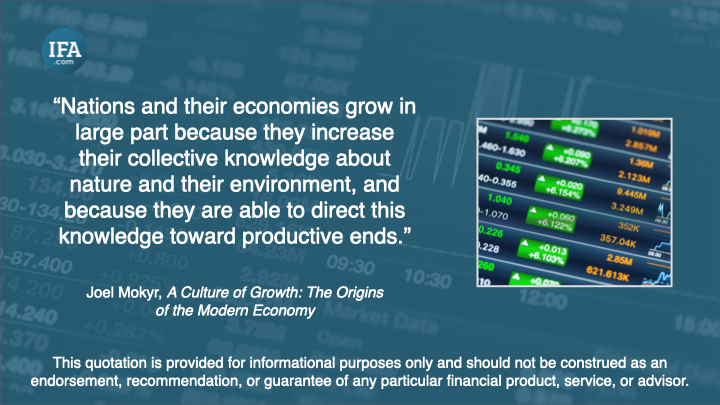
Aghion and Howitt's Engine: Creative Destruction as Growth Mechanism
While Mokyr explained the institutional prerequisites, Philippe Aghion and Peter Howitt provided the mathematical model of how knowledge becomes economic growth. Their 1992 paper formalized the process Joseph Schumpeter described: firms invest in research and development to climb an "innovation ladder," earning temporary monopoly profits that attract rivals to innovate further and displace them.
In their framework, competition creates what they term the "competition avoidance effect." Incumbent leaders must keep innovating or face displacement by challengers. This competitive pressure never relents. Each successful innovation raises the bar, creating a continuous cycle of replacement and improvement.
The model explains several investor-relevant phenomena. Corporate dominance is inherently temporary. Market leadership generates the profits that fund the next generation's challenge. Trying to pick which firms will climb the ladder next is extraordinarily difficult — the displacement mechanism operates precisely because outcomes are uncertain and depend on continuous R&D races. Smooth aggregate growth can coexist with intense individual company turnover. Micro-turbulence creates macro-stability.
As the Nobel Committee emphasized, Aghion and Howitt showed mathematically how "newer, superior products continuously enter markets and displace companies selling older versions." This isn't market failure—it's the growth mechanism itself. The churn is the engine.
For index investors, this validates a crucial principle: market cap weighting automatically captures this displacement cycle. As firms climb the innovation ladder, their market values rise and they occupy larger portfolio weights. As they're displaced, their weights shrink. No forecasting required. The methodology embeds the creative destruction process directly into portfolio construction.
The Unified Framework: Open Knowledge Meets Contestable Markets
The laureates' combined work establishes that sustained growth requires two conditions working in concert: open knowledge systems (Mokyr) and competitive markets (Aghion-Howitt). When societies maintain institutions that spread useful knowledge while enforcing competition that prevents entrenched monopolies from blocking innovation, the result is sustained productivity growth.
This framework explains capitalism's remarkable resilience through disruptions that seemed existential. The 1930s Depression, two world wars, 1970s stagflation, the 2008 financial crisis, the 2020 pandemic — each prompted predictions of systemic collapse. Yet the institutional framework Mokyr identified persisted, and the competitive dynamic Aghion and Howitt modeled continued driving renewal.
The system adapts not through stability but through constant replacement. As the Nobel Committee noted, this creates "a never-ending cycle" where "new products and production methods [replace] old ones." Index investors participate in this cycle by owning the process rather than betting on specific outcomes.
The Evidence in Market History
In his book, Index Funds: The 12-Step Recovery Program for Active Investors, Mark Hebner anticipated these Nobel insights by documenting how creative destruction operates in actual markets.
Corporate Turnover as Creative Destruction
Hebner cited McKinsey consultants Richard Foster and Sarah Kaplan's research examining the original S&P 500 companies from 1957. Only 74 companies remained on the list by 1997, and just 12 outperformed the index over that 41-year period.
This isn't market dysfunction — it's the Aghion-Howitt model operating exactly as predicted. The companies changed, but the index captured the renewal automatically. Shareholders who owned the process rather than betting on specific winners prospered through four decades of technological transformation because market cap weighting systematically shifted capital toward emerging leaders as established dominants faded.
The Foster and Kaplan research validates the central investment challenge the Nobel laureates identified: predicting which firms will successfully climb the innovation ladder is extraordinarily difficult. But capturing the entire ladder — participating in the full competitive cycle — has proven remarkably effective. The index methodology doesn't require forecasting; it embeds the displacement mechanism into the rebalancing process.
Capitalism's Demonstrated Resilience
Hebner's analysis of long-term market returns in his book demonstrates the resilience the Nobel framework explains. "Capitalism has proven to be quite resilient in adapting to technological change and economic shocks," he observes in Step 9. "Despite several setbacks, capitalism has not only persevered but thrived."
This resilience appears in the data. Based on 94 years of returns ending in 2021, Hebner calculated that the expected return for bearing "capitalism risk" — the systematic, non-diversifiable risk of participating in the market system — has been approximately 9.3% annually. Through depression, world wars, stagflation, financial crisis, and pandemic, patient investors were rewarded for maintaining exposure to the system's capacity for renewal.
The Nobel framework explains why this track record exists. The institutional mechanisms Mokyr identified — open knowledge systems, competitive political fragmentation, reputational incentives for discovery — have remained largely intact. The competitive pressure Aghion and Howitt modeled has continued forcing innovation even through severe disruptions. The combination has proven durable enough to reward long-term participation despite short-term turbulence.
"Market history demonstrates the enduring nature of capitalism," Hebner concludes, "and how a long-term investor is likely to benefit from an investment in global capitalism." The laureates provide the intellectual framework for what Hebner documented empirically.
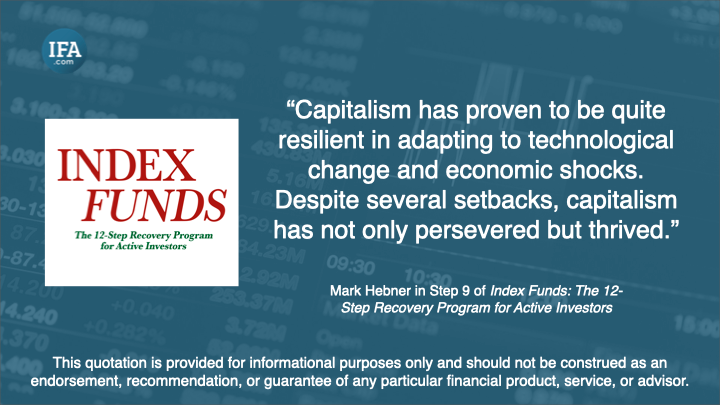
The Global Scale of Adaptation
Hebner illustrated the system's structural capacity with compelling scale in Step 11: "With a total market capitalization of $77 trillion, more than 14,000 CEOs worldwide, and almost 69 million employees selling products in 195 countries, it is not reasonable to believe that Capitalism, Inc. will go out of business."
The Nobel framework adds crucial nuance. This isn't just diversification providing safety through numbers — it's thousands of parallel innovation experiments with automatic capital reallocation toward success. Mokyr's research shows that geographic and political distribution prevents single points of failure while maintaining competitive pressure. No single nation or authority can turn off global innovation; the system's fragmented structure protects its dynamism.
Aghion and Howitt's model explains how this scale translates into continuous renewal. With thousands of firms competing simultaneously across multiple markets, the innovation ladder operates constantly. Some firms climb while others descend. Market cap weighting captures this turbulence automatically, shifting portfolio weights toward successful innovators without requiring identification ex ante.
As Hebner emphasizes, "Investors should think of their portfolios as investments in global capitalism." The laureates explain what that system actually is: a continuous process of knowledge accumulation and competitive displacement that has proven capable of sustained adaptation.
What the Nobel Framework Clarifies
The Nobel laureates explain why broad market participation has worked for two centuries: you're owning a self-renewing system, not a static collection of companies.
The Aghion-Howitt model demonstrates that market cap weighting automatically shifts exposure toward firms climbing the innovation ladder — no forecasting required. As successful innovators grow, their portfolio weights increase organically. As they're displaced, weights decline automatically. The methodology embeds the creative destruction cycle into rebalancing.
Mokyr's framework clarifies why this renewal process has persisted through technological transitions that seemed existential. The institutional prerequisites he identified — open knowledge systems, political fragmentation protecting intellectual freedom, reputational incentives for discovery — have remained largely intact even during severe disruptions. Steam gave way to electricity, mainframes to personal computers, brick-and-mortar retail to e-commerce. The companies changed; the renewal mechanism persisted.
Three implications follow:
Geographic diversification captures adaptation wherever it emerges. Mokyr's historical research demonstrates that innovation geography has always shifted. No nation maintains permanent technological advantage. Broad global exposure participates in renewal regardless of where breakthroughs occur, while the system's geographic distribution strengthens its resilience against local disruptions.
Volatility reflects the displacement mechanism, not system failure. The creative destruction process feels turbulent because renewal requires incumbent displacement. Market volatility often spikes precisely when the innovation ladder operates most dynamically — when emerging technologies challenge established leaders, when competitive pressure intensifies, when the replacement cycle accelerates. Historical returns have rewarded investors who remained participants through this turbulence.
Patience compounds the adaptive advantage. The Aghion-Howitt model operates over investment cycles measured in years and decades, not quarters. Individual firms rise and fall on varying timelines. The innovation ladder processes thousands of competitive experiments simultaneously. Pre-committing to sustained participation captures both phases — when incumbents fade and when successful innovators expand. Market timing attempts to separate them typically fail because the phases are inseparable and unpredictable.
The Nobel framework doesn't change what to do. It clarifies why broad market participation has rewarded patient investors historically and what you're actually capturing when you own globally diversified portfolios.
Informed Confidence
The 2025 Nobel Prize offers something increasingly rare in investing: an intellectually rigorous explanation for capitalism's two-century track record of sustained growth. Joel Mokyr, Philippe Aghion, and Peter Howitt don't promise perpetual prosperity—they explain the mechanisms that have proven remarkably durable through every previous disruption.
For index investors, this provides informed confidence rather than blind faith. You're not betting that nothing will change—you're participating in a system specifically designed to change. The companies in your portfolio will change; that's the mechanism, not a malfunction. Market cap weighting captures that renewal automatically.
Market history demonstrates that the system has rewarded disciplined, long-term investors through two centuries of transformation. The Nobel framework explains why: the institutional foundations Mokyr identified have remained largely intact, and the competitive dynamics Aghion and Howitt modeled continue driving renewal.
Will it continue? As long as knowledge systems remain open and markets remain contestable. Historical evidence suggests both conditions have proven surprisingly resilient. John Hassler, chair of the Nobel Committee, captured the responsibility: "The laureates' work shows that economic growth cannot be taken for granted. We must uphold the mechanisms that underlie creative destruction."
That's not a guarantee, but it's a far stronger foundation than most investment strategies can claim. You're participating in a documented, Nobel-validated process of continuous renewal that has adapted successfully for two hundred years. Market history shows this has rewarded patient investors. The Nobel framework explains why.
Resources
Aghion, P., & Howitt, P. (1992). A model of growth through creative destruction. Econometrica, 60(2), 323–351.
Foster, R., & Kaplan, S. (2001). Creative destruction: Why companies that are built to last underperform the market — and how to successfully transform them. Currency/Doubleday.
Hebner, M. T. (2016). Index Funds: The 12-Step Recovery Program for Active Investors (5th ed.). IFA Publishing.
Mokyr, J. (2002). The gifts of Athena: Historical origins of the knowledge economy. Princeton University Press.
Mokyr, J. (2016). A culture of growth: The origins of the modern economy. Princeton University Press.
ROBIN POWELL is the Creative Director at Index Fund Advisors (IFA). He is also a financial journalist and the Editor of The Evidence-Based Investor. This article reflects IFA's investment philosophy and is intended for informational purposes only.
DISCLOSURES:
This content is for informational purposes only and does not constitute investment advice, an offer, or a solicitation to buy or sell any security.Referenced research and studies are provided for informational purposes and illustrate general principles. Readers should recognize that results derived from statistical methods, including multiple hypothesis testing, may include findings attributable to chance. Statistical significance does not guarantee predictive reliability. We recommend consulting a fiduciary or qualified financial advisor before making any investment decisions to ensure alignment with personal financial goals, risk tolerance, and circumstances. Past performance is not indicative of future results. All investments involve risk, including the possible loss of principal. Examples are for illustration only. Any references to specific managers or funds are not recommendations and are provided solely to discuss general principles. Benchmarks are unmanaged and cannot be invested in directly.
IFA does not endorse or guarantee the accuracy of third-party content. Any references to specific fund families, managers, or strategies are provided solely for illustrative purposes and should not be construed as endorsements, recommendations, or guarantees of performance. Past performance does not imply future results.
Quotes and images included are for illustrative purposes only and should not be considered as endorsements, recommendations, or guarantees of any particular financial product, service, or advisor. IFA does not endorse or guarantee the accuracy of third-party content. For those seeking additional insights into the challenges of market timing, Step 4 of Mark Hebner's award-winning book ‘Index Funds: The 12-Step Recovery Program for Active Investors' offers a detailed perspective. This book is available free of charge here. References to third-party resources, including books, are informational and do not constitute endorsements or solicitations. IFA does not receive compensation related to this recommendation
For additional information about IFA, including detailed information about services, compensation, and potential conflicts of interest, please review our brochure available both at www.adviserinfo.sec.gov and www.ifa.com.

